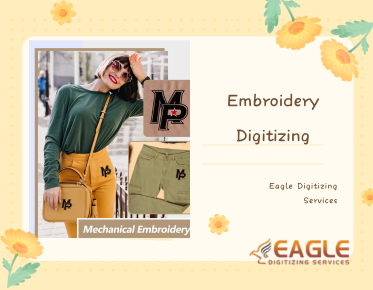Creative Design Manipulation in Digitized Embroidery
In the vibrant world of embroidery, digitization has revolutionized the way we create and manipulate designs. Moving from traditional hand-stitched techniques to advanced digital methods, this art form has taken on a new dimension. Let's delve into the fascinating realm of digitized embroidery and explore the techniques and tools that make it so innovative.
The Basics of Embroidery Design Manipulation
Definition and Importance
Design manipulation in embroidery refers to the process of altering and refining designs to achieve the desired outcome. This could involve adjusting stitch types, resizing elements, or tweaking colors. Mastering these techniques is crucial for creating high-quality, customized embroidery.
Key Tools and Software Used
Several software tools are essential for design manipulation in embroidery. Programs like Wilcom, Brother PE-Design, and Hatch Embroidery offer robust features for editing and creating designs. These tools allow users to convert vector art into embroidery files, adjust stitch patterns, and preview designs before stitching.
Basic Techniques and Principles
Some fundamental techniques include layering, where different stitch types and colors are used to create depth; texturing, which adds a tactile dimension to designs; and resizing, which ensures that designs maintain their integrity regardless of scale. Understanding these principles is key to producing professional-quality embroidery.
Popular Software for Digitized Embroidery
Overview of Leading Software
Embroidery software is the backbone of digitized embroidery. Leading programs like Wilcom, Hatch, and Brother PE-Design are favored by professionals for their comprehensive features and user-friendly interfaces. Each offers unique tools for design creation, editing, and file conversion.
Features to Look For
When selecting embroidery software, consider features such as vector art compatibility, stitch simulation, and customization options. Advanced tools like auto-digitizing, which converts images into embroidery files automatically, can also be highly beneficial for speeding up the design process.
Pros and Cons of Popular Choices
Wilcom is known for its advanced features and professional-grade quality but comes with a steep learning curve. Hatch offers excellent user support and is more accessible for beginners, though it may lack some high-end capabilities. Brother PE-Design is versatile and integrates well with Brother machines but can be expensive.
The Role of Vector Art in Embroidery
Understanding Vector Art
Vector art is composed of paths defined by mathematical equations, making it scalable without loss of quality. This is crucial in embroidery, where designs need to be resized for different applications. Unlike raster images, which are pixel-based, vector art ensures clean, crisp lines at any size.
How Vector Art Translates to Embroidery
In embroidery, vector art is converted into stitch patterns. Each line and shape in the vector design corresponds to a series of stitches. This translation process allows for high precision and detail, making vector art an ideal starting point for embroidery designs.
Creating and Editing Vector Art for Embroidery
Creating vector art requires software like Adobe Illustrator or CorelDRAW. Once created, these designs can be imported into embroidery software for conversion. Editing vector art involves adjusting paths, modifying shapes, and ensuring that the design elements are suitable for stitching.
File Formats and Compatibility
Common Embroidery File Formats
Embroidery machines use specific file formats like DST, PES, and EXP. Each format corresponds to different brands and models of machines. Understanding these formats and their compatibility is essential for ensuring that your designs are correctly interpreted by the embroidery machine.
Converting Between Formats
Sometimes, designs need to be converted from one format to another. This can be done using embroidery software, which often includes tools for file conversion. Ensuring accurate conversion is vital to maintaining the integrity of the design across different machines.
Ensuring Compatibility Across Platforms
To avoid issues, ensure that your designs are compatible with the embroidery machine and software you are using. This may involve testing designs on multiple machines or using universal formats that work across different platforms.
Digitizing Techniques for Beginners
Step-by-Step Guide for Novices
For beginners, start by selecting a simple design and importing it into your embroidery software. Use auto-digitizing features to convert the design into an embroidery file, then refine it by adjusting stitch types and directions. Finally, test the design on your machine to ensure it stitches correctly.
Common Mistakes to Avoid
Avoid overly complex designs that can lead to thread breaks and fabric distortion. Ensure that your design elements are appropriately scaled and that stitch density is not too high, which can cause puckering. Practice and patience are key to mastering the basics.
Tips for Getting Started
Start with basic designs and gradually move to more complex patterns as you gain confidence. Join online forums and communities for support and feedback. Invest time in learning your software’s features and experimenting with different techniques.
Advanced Design Manipulation Techniques
Layering and Texturing
Advanced techniques like layering and texturing add depth and dimension to embroidery. Layering involves using different stitch types and colors to create a 3D effect, while texturing adds tactile interest to the design.
Using Gradients and Blending
Gradients and blending techniques create smooth transitions between colors, enhancing the visual appeal of the embroidery. This can be achieved by varying stitch density and using overlapping stitches to blend colors seamlessly.
Advanced Stitch Techniques
Techniques such as satin stitching, fill stitching, and appliqué are essential for creating detailed and intricate designs. Experimenting with these stitches and combining them creatively can elevate the quality of your embroidery.
Customizing Pre-Made Designs
How to Alter Existing Designs
Customizing pre-made designs involves modifying elements such as size, color, and stitch type. This allows you to personalize the design to fit specific needs or preferences. Use your software’s editing tools to make precise adjustments.
Adding Personal Touches
Incorporate personal elements like initials, dates, or custom motifs into pre-made designs. This adds a unique touch and makes the embroidery more meaningful. Ensure these additions are well-integrated with the existing design.
Best Practices for Customization
When customizing designs, maintain a balance between originality and the integrity of the original design. Test alterations on a sample fabric to ensure they work well before finalizing. Keep track of changes for future reference.
Creating Your Own Designs from Scratch
Concept to Creation Process
Start with a concept or inspiration, then sketch your design on paper or digitally. Transfer this sketch to your embroidery software and begin digitizing, and converting the design into stitch patterns. Refine and test the design until it meets your standards.
Tips for Original Design Creation
Draw inspiration from various sources, including nature, art, and fashion. Focus on creating designs that are unique and reflective of your personal style. Pay attention to details and be open to experimentation.
Tools and Resources for Inspiration
Utilize tools like Pinterest, design blogs, and embroidery forums for inspiration. Books and magazines on embroidery can also provide valuable insights and ideas. Keeping an inspiration journal can help capture and develop your creative concepts.
Incorporating Text into Embroidery Designs
Font Selection and Sizing
Choosing the right font is crucial for readability and aesthetic appeal. Select fonts that complement your design and are legible when stitched. Adjust the size to ensure the text is clear and fits well within the overall design.
Placement and Alignment
Proper placement and alignment of text enhance the design's overall balance. Use your software’s alignment tools to position text accurately. Consider the design’s focal points and ensure the text does not overshadow other elements.
Special Effects and Styles
Incorporate special effects like shadowing, outlining, and gradient fills to make the text stand out. Experiment with different styles to find what best complements your design. Ensure these effects are subtle and enhance readability.
Color Theory in Embroidery
Basics of Color Theory
Understanding color theory helps in selecting harmonious color combinations. Knowledge of the color wheel, complementary colors, and color contrasts is essential for creating visually appealing designs.
Choosing the Right Color Palette
Select a color palette that suits the design's theme and purpose. Consider the fabric color and the thread's sheen. Test different combinations to see how they interact when stitched on fabric.
Color Blending and Shading
Blending and shading add depth and dimension to embroidery. Use techniques like gradient fills and overlapping stitches to create smooth transitions between colors. This enhances the design's realism and complexity.
Scaling Designs Up or Down
Maintaining Quality When Resizing
When resizing designs, maintain the stitch density and adjust the stitch length accordingly. This ensures the design retains its quality and detail. Avoid scaling too drastically, as this can distort the design.
Proportions and Stitch Density
Keep the design's proportions intact to avoid skewing. Adjust the stitch density based on the new size to ensure even coverage and avoid gaps. Use your software’s scaling tools to make precise adjustments.
Practical Tips for Resizing
Test resized designs on fabric to check for quality. Make incremental changes rather than drastic ones to maintain detail. Save multiple versions of the design at different sizes for flexibility.
Optimizing Designs for Different Fabrics
Fabric Types and Their Characteristics
Different fabrics have unique characteristics that affect embroidery. For instance, stretchy fabrics require more stabilization, while dense fabrics may need less stitch density. Understanding these traits is crucial for optimal results.
Adjusting Designs for Different Textures
Modify your designs to suit the fabric's texture. For example, use lighter stitches on delicate fabrics and heavier stitches on sturdy materials. Test your designs on fabric samples to ensure they stitch well.
Testing and Tweaking for Best Results
Always test your designs on a fabric swatch before finalizing. Make necessary adjustments based on the test results. This helps in identifying potential issues and refining the design for the best outcome.
Troubleshooting Common Issues
Common Design Flaws and Fixes
Address common issues such as thread breaks, puckering, and uneven stitches. Ensure proper tension settings and stabilize the fabric adequately. Regularly clean and maintain your machine to avoid mechanical problems.
Addressing Software Glitches
Stay updated with your software's latest versions to prevent glitches. If issues arise, refer to user manuals, online forums, or customer support for solutions. To prevent data loss, make regular backups of your designs.
Dealing with Thread Breaks and Fabric Issues
Use high-quality thread and needles that are appropriate for your clothing type. Adjust the machine's speed and tension settings to prevent thread breaks. Test different stabilizers and hooping techniques to find what works best for your project.
Digitized embroidery offers endless possibilities for creativity and customization. From understanding the basics to mastering advanced techniques, this art form combines tradition with technology. The right tools, techniques, and inspiration are essential for creating stunning designs.
Embroidery is a journey of exploration and creativity. Don't be scared to experiment with new concepts and methods. Every project presents an opportunity to learn and improve as a designer.



